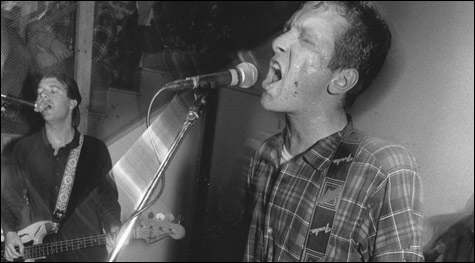
BANDWAGONESQUE: The major labels signed Buffalo Tom and just about anyone whose buzz could conceivably translate into Nirvana-like sales. |
In his newly published The Sound of Our Town: A History of Boston Rock & Roll (Commonwealth Editions), long-time Phoenix contributor Brett Milano explores the evolution of the local music scene, from obscurities like the G-Clefs’ 1956 hit “K-Ding Dong” up through more familiar names like Aerosmith, J. Geils, Mission of Burma, the Pixies, the Bosstones, Morphine, Dropkick Murphys, Dresden Dolls . . . the list goes on. To celebrate its publication, a hearty cross-section of the local rock scene are gathering to perform downstairs at the Middle East this Saturday. Here’s an excerpt adapted from a chapter that deals with the impact the post-Nirvana major-label feeding frenzy had on local rockers like Buffalo Tom.
— Matt Ashare, Music Editor
How do you know that your band’s suddenly become a big deal? When you’re still living in a dinky apartment in Somerville, and a white stretch limo shows up to take you to the airport. Bill Janovitz, Buffalo Tom’s singer and guitarist, woke up to find that monstrosity outside his Davis Square house one morning in 1992, soon after their song “Taillights Fade” became a left-field hit. The limo was so out of synch with Buffalo Tom’s roots as a rough-edged, club- and college-bred band that the bass player refused to get in. “Chris Colbourn was mortified. He grabbed his suitcase and said, ‘I’m taking the subway,’ ” Janovitz recalls. “I got in, because I’m all about convenience. My feeling was, ‘Hey, we’re not paying for this, so let’s enjoy it.’ ”

Scenes like this happened to countless bands in 1993, the year of the indie-rock gold rush. Suddenly it seemed that the major labels were everywhere, throwing money around. So you’re in a proudly underground, punk-inspired band that you thought was too raw for radio, too weird for pop stardom? No problem. They’d still find a place for you on MTV, on a film soundtrack, maybe even in a teen magazine. You too could get a major-label record deal with a six-figure advance. Maybe you could even quit your day job.
The moment had been a long time coming. During the ’80s, there was still a clear division between the commercial bands and the independent ones; if you were doing something a little raw, weird, or punk-inspired, there was only so far you could go. Many of the ’80s bands that history remembers as great and influential — Sonic Youth from New York, the Replacements and Hüsker Dü from Minneapolis, X and Black Flag from Los Angeles, and, of course, the Pixies and Mission of Burma from Boston — never made it to the top. Most signed with major labels and wound up playing theaters, but none found superstardom, sold platinum, or made it far on commercial radio, which was still busy wearing out Led Zeppelin albums from the ’70s. The mid-’80s success of the Georgia band R.E.M. at least proved that one great band could crash the commercial gates; but R.E.M., as much as it wanted to, never managed to drag dozens of other misfit bands into the spotlight.
The band that finally changed the world wasn’t even trying. The Seattle trio Nirvana had already been around for two years before most of the world noticed. At one of Nirvana’s first Boston-area shows, in 1990, the band played the tiny Jamaica Plain rock bar Green Street Station, sharing a bill with the noisy Boston band the Cheater Slicks. (Asked about that show years later, Dave Shannon, the Cheater Slicks’ guitarist, said, “We figured, big deal — a bunch of hippies from Seattle.”) Yet, Nirvana’s second album, Nevermind, nearly changed the climate overnight when it was released in September 1991. Nirvana’s leader, Kurt Cobain — a disheveled cynic with a heroin problem and bad taste in clothes — was nobody’s idea of a pop star. But there was something hugely affecting about his songs and hugely energizing about the band’s guitar sound; Nevermind’s producer, Butch Vig, knew how to exploit both. And the music business reacted to Nirvana’s runaway success the only way it knew how: by looking everywhere for more of the same.
What happened in Boston post-Nirvana was the equivalent of that white limo pulling up at Bill Janovitz’s house. Sometimes it seemed that youth culture was being recast in Kurt Cobain’s image: soulful, alienated, and streetwise teens were turning up on MTV, in mainstream television shows (90210 and My So-Called Life), and in newly aware teen mags such as the late, lamented Sassy, with its coveted “Cute Band Alert.” (To its eternal embarrassment, Buffalo Tom could manage only a “Cute Drummer Alert.”) Two area bands, Boston’s Green Magnet School and Providence’s Six Finger Satellite, were also signed to Nirvana’s original label, Sub Pop. According to the guitarist Chris Pearson, the former band was signed because the label owner thought they recalled English punk. “But of course, when our album came out, all the English critics compared us to Nirvana.”